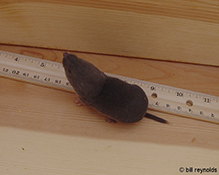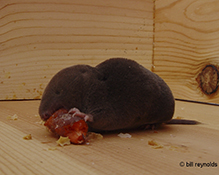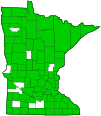Northern Short-tailed Shrew
(Blarina brevicauda)
Conservation • Description • Habitat • Ecology • Distribution • Taxonomy
Conservation Status |
|||
| IUCN Red List | LC - Least Concern |
||
| NatureServe | N5 - Secure S5 - Secure |
||
| Minnesota | not listed |
||
Description
Northern Short-tailed Shrew is the largest and most widespread shrew in eastern North America. It is the most common shrew in Minnesota. Its population fluctuates greatly, at times abundant, up to 12 per acre, at other times in the same area as few as 2 per acre.
Adults are 3″ to 4⅛″ in length from nose to tail, 4⅜″to 5½″ in length including the tail. They weigh from ⅝ to 1¼ ounces. Males are slightly larger than females, especially in skull size.
The coat (pelage) is dark gray, thick, short, soft, and velvety. It molts in October to November and February to July. The winter coat is slightly darker and may have a brownish cast. The summer coat is almost uniformly dark gray. The belly is lighter gray. Juveniles are paler than adults.
The body is stocky. The legs are short. The feet are relatively thick and broad. There are five toes on every foot. The tail is short, ⅝″ to 13 ⁄16″ long, about ¼ as long as the head and body together. It is covered with hair. Females have six mammae. Like all shrews, males have one scent gland, up to ½″ long, on each side between the fore and hind legs. On females these glands are less prominent or rudimentary. Unlike other shrews, they also have a scent gland in the groin area. This gland is up to 13 ⁄16″ long and ⅜″ wide and is active in both males and females.
The snout is long and sharply pointed. The ears are short and inconspicuous, mostly hidden by the fur. The eyes are tiny and barely apparent. The skull has 32 teeth that are at least in part chestnut-colored. The space between the incisors and molars is less than the width of the widest molar. Canine teeth are present. There are 6 upper and 2 lower incisors. The first upper incisor is greatly enlarged. A pair of glands on each side behind the lower jaw contain a poisonous venom. The venom is released through a duct below the lower incisors and is conducted into prey by way of a groove formed between the two teeth.
Giant mole shrew (Blarina brevicauda brevicauda), as the name suggests, is the largest subspecies, 5″ to 5½″in total length including the tail.
Manitoba Short-tailed Shrew (Blarina brevicauda manitobensis) is slightly smaller. The pelage is slightly darker.
Northern Short-tailed Shrew (Blarina brevicauda talpoides) is a medium-sized subspecies, about 45 ⁄16″ long.
Size
Total length: 4⅜″to 5½″
Head and body: 3″ to 4⅛″
Tail: ⅝″ to 13 ⁄16″
Sign
Shrew tracks are unlikely except in fresh snow. A shrew bounds (hops) like a squirrel. The two front feet land first, next to each other, then the back feet land next to each other and a little ahead of the front feet. The trail is similar to some species of mice but narrower, 1″ to 1¼″ in width.
Similar Species
Habitat
Almost all terrestrial, moist to moderately moist habitats with brushy cover or deep leaf litter, especially bogs and swamps, deciduous and coniferous woodlands, and grassy roadsides and fencerows in agricultural areas.
Ecology
Behavior
Northern Short-tailed Shrew is solitary and territorial. It marks its territory using scent glands and drives intruders away. Its home range varies by availability of prey but averages about 6 acres, overlapping that of its neighbors.
It spends most of its time underground. It is active day and night but mostly at night. It is a good burrower and constructs an elaborate tunnel system and nest, usually under a fallen log or stump. The nest is up to 8″ in diameter and is lined with the fur of meadow voles. It will sometimes use the tunnel of another species.
It has a poor sense of smell and very poor vision. It can navigate and detect objects in its environment using echolocation and and touch. Like bats, it emits a series of ultrasonic squeaks to detect its surroundings. Unlike bats, it does not use echolocation to locate prey. Its snout and whiskers are highly sensitive to touch.
Lifespan
2½ years
Life Cycle
In Minnesota, breeding season is from May to August or later. The female will have 2 to 4 litters each year. About 17 to 24 days after mating she gives birth to from 3 to 10, usually 4 to 6, young. The young leave the nest in 18 to 20 days. They reach sexual maturity at 60 days. Most probably die in their first year from predation and cold stress. Those that survive the first year may live up to 2½ years.
Food
Northern Short-tailed Shrew is a carnivore and invertivore. It eats mostly small vertebrates, including voles, mice, and other shrews; and invertebrates, including snails, earthworms, and beetles. It also eats a variety of plant materials and fungi. It may hoard food, especially snails, at least in winter. It eats up to three times its weight each day in winter, less in summer.
Toxicity
The venom allows the shrew to paralyze its prey and eat it at a later time. It is sufficiently strong to kill animals up to the shrew’s size, and to produce a very painful reaction in humans who handle the shrew.
Distribution |
||
|
Sources Biodiversity occurrence data published by: Minnesota Biodiversity Atlas (accessed through the Minnesota Biodiversity Atlas Portal, bellatlas.umn.edu, 12/4/2025). Timm, R. M. 1975. Distribution, natural history, and parasites of mammals of Cook County, Minnesota. Occasional Papers, Bell Museum of Natural History, University of Minnesota 14:1–56. Hazard, Evan B. 1982. The Mammals of Minnesota. University of Minnesota Press, Minneapolis, Minnesota. 280 pp. The counties in light green lack modern records but have historic county or township specimens or records. |
|
| 12/4/2025 | ||
Northern Short-tailed Shrew (B. b. talpoides), the eastern subspecies, is the most widespread in North America. It is found only in the northeastern quarter of Minnesota. Northern Short-tailed Shrew (B. b. brevicauda) is found in the remainder of the state. Manitoba Short-tailed Shrew (B. b. manitobensis) is probably found in northwestern Minnesota. |
||
Occurrence |
||
Widespread, common, and often abundant |
||
Taxonomy
Class
Subclass
Theria
Infraclass
Placentalia (Placental Mammals)
Magnorder
Boreoeutheria
Superorder
Euarchontoglires (Primates, Rodents, and Allies)
Order
Eulipotyphla (Shrews, Moles, Hedgehogs, and Allies)
Suborder
Erinaceota (Shrews, Moles, and Hedgehogs)
Superfamily
Soricoidea
Family
Soricidae (Shrews)
Subfamily
Soricinae (Red-toothed Shrews)
Tribe
Blarinini (Short-tailed and Small-eared Shrews)
Genus
Blarina (Short-tailed Shrews)
Order
Shrews and moles were formerly included in the order Insectivora, a “waste basket” taxon. Insectivora was shown to have multiple ancestral sources (polyphyletic), and was split into four new orders. Shrews and moles were placed in the new order Soricomorpha. More recent molecular analysis resulted in a reshuffling of the families into just two orders, placing shrews and moles in the order Eulipotyphla.
Subordinate Taxa
Dismal Swamp Short-tailed Shrew (Blarina brevicauda telmalestes)*
Kirtland’s Short-tailed Shrew (Blarina brevicauda kirtlandi)
Manitoba Short-tailed Shrew (Blarina brevicauda manitobensis) ![]() ?
?
Martha’s Vineyard Short-tailed Shrew (Blarina brevicauda aloga)
Nantucket Short-tailed Shrew (Blarina brevicauda compacta)
Northern Short-tailed Shrew (Blarina brevicauda angusta)
Northern Short-tailed Shrew (Blarina brevicauda brevicauda) ![]()
Northern Short-tailed Shrew (Blarina brevicauda churchi)
Northern Short-tailed Shrew (Blarina brevicauda hooperi)
Northern Short-tailed Shrew (Blarina brevicauda pallida)
Northern Short-tailed Shrew (Blarina brevicauda talpoides) ![]()
Ozark Short-tailed Shrew (Blarina brevicauda ozarkensis)
------------------------------------------
* Some authors consider Dismal Swamp short-tailed shrew a separate species, Blarina telmalestes.
Synonyms
Blarina fossilis
Blarina kirtlandi
Blarina ozarkensis
Blarina simplicidens
Blarina talpoides
Corsira talpoides
Sorex brevicaudus
Sorex talpoides
Talposorex platyurus
Common Names
Giant Mole Shrew
Mole Shrew
Northern Short-tailed Shrew
Short-tailed Shrew
Glossary
Pelage
The coat of a mammal, consisting of fur, wool, or hair, and including a soft undercoat and stiff guard hairs.
Poisonous Mammals
Northern Short-tailed Shrew is the only poisonous mammal on the North American mainland. Cuban solenodon (Solenodon cubanus) and the Haitian solenodon (Solenodon paradoxus) are are also poisonous mammals found on the North America continent, the former in Cuba, the latter in Haiti.
Odor
Shrews have a distinctive odor. It has been suggested that this is a defense mechanism against predators but this is controversial. Hawks and owls have poorly developed senses of smell and do not seem to be repelled by the shrew odor. Shrews are also preyed on by snakes, weasels, Red Fox, and coyotes.
Visitor Photos
Share your photo of this mammal.
This button not working for you?
Simply email us at info@MinnesotaSeasons.com.
Attach one or more photos and, if you like, a caption.
Bill Reynolds |
||
 |
 |
|
MinnesotaSeasons.com Photos
|

Slideshows
Shrew
DianesDigitals

Visitor Videos
Share your video of this mammal.
This button not working for you?
Simply email us at info@MinnesotaSeasons.com.
Attach a video, a YouTube link, or a cloud storage link.
Other Videos
Northern Short-tailed Shrew (Blarina brevicauda)
Thamnophis X
Shorttail Shrew (Soricidae: Blarina brevicauda) Dead on Footpath
Carl Barrentine
Mammals of the World: Northern Short-tailed Shrew
cre8ivmind
Animals Attack: Shrew vs. Snake
National Geographic
Northern Short Tailed Shrew
geop147

Visitor Sightings
Report a sighting of this mammal.
This button not working for you?
Simply email us at info@MinnesotaSeasons.com.
Be sure to include a location.
Karley
7/16/2019
Location: Belleville, Ontario
they're adorable!
Minnesota Seasons Sightings






